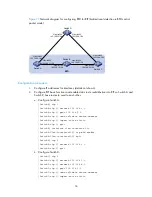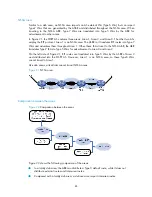
81
•
Each OSPF router collects LSAs from other routers to compose an LSDB. An LSA describes
the network topology around a router, so the LSDB describes the entire network topology of
the AS.
•
Each router transforms the LSDB in the area to a weighted directed graph, which actually
reflects the topology architecture of the entire network. All the routers of the area have the
same graph.
•
Each router uses the SPF algorithm to compute a Shortest Path Tree that shows the routes to
the nodes in the autonomous system. The router itself is the root of the tree.
Router ID
An OSPF process running on a router must have its own router ID, which is a 32-bit unsigned
integer, the unique identifier of the router in the AS.
OSPF packets
OSPF uses the following types of packets:
•
Hello packet: Periodically sent to find and maintain neighbors, containing the values of
some timers, information about the DR, BDR, and known neighbors.
•
DD packet: Describes the digest of each LSA in the LSDB, exchanged between two routers
for data synchronization.
•
LSR packet: Requests needed LSAs from the neighbor. After exchanging the DD packets, the
two routers know which LSAs of the neighbor are missing from the local LSDBs. Then, they
send an LSR packet to each other, requesting the missing LSAs. The LSA packet contains the
digest of the missing LSAs.
•
LSU packet: Transmits the needed LSAs to the neighbor.
•
LSAck packet: Acknowledges received LSU packets. It contains the headers of received LSAs
(a packet can acknowledge multiple LSAs).
LSA types
OSPF sends routing information in LSAs, which, as defined in RFC 2328, have the following
types:
•
Router LSA: Type-1 LSA, originated by all routers, flooded throughout a single area only.
This LSA describes the collected states of the router's interfaces to an area.
•
Network LSA: Type-2 LSA, originated for broadcast and NBMA networks by the designated
router, flooded throughout a single area only. This LSA contains the list of routers connected
to the network.
•
Network Summary LSA: Type-3 LSA, originated by ABRs, and flooded throughout the LSA's
associated area. Each summary-LSA describes a route to a destination outside the area, yet
still inside the AS (an inter-area route).
•
ASBR Summary LSA: Type-4 LSA, originated by ABRs and flooded throughout the LSA's
associated area. Type 4 summary-LSAs describe routes to ASBR.
•
AS External LSA: Type-5 LSA, originated by ASBRs, and flooded throughout the AS (except
stub and NSSA areas). Each AS-external-LSA describes a route to another AS.
Summary of Contents for S9500E Series
Page 435: ...435 ...
















































